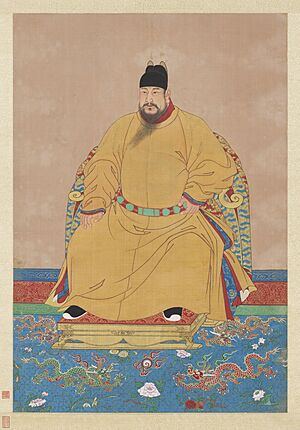Hongxi Emperor facts for kids
Quick facts for kids Hongxi Emperor洪熙帝 |
|||||||||||||||||
|---|---|---|---|---|---|---|---|---|---|---|---|---|---|---|---|---|---|

|
|||||||||||||||||
| Emperor of the Ming dynasty | |||||||||||||||||
| Reign | 7 September 1424 – 29 May 1425 | ||||||||||||||||
| Enthronement | 7 September 1424 | ||||||||||||||||
| Predecessor | Yongle Emperor | ||||||||||||||||
| Successor | Xuande Emperor | ||||||||||||||||
| Crown Prince of the Ming dynasty | |||||||||||||||||
| Tenure | 12 May 1404 – 7 September 1424 | ||||||||||||||||
| Predecessor | Zhu Wenkui, Crown Prince Hejian | ||||||||||||||||
| Successor | Imperial Grandson-heir Zhu Zhanji | ||||||||||||||||
| Hereditary Prince of Yan | |||||||||||||||||
| Tenure | 4 November 1395 – 17 July 1402 | ||||||||||||||||
| Born | 16 August 1378 Hongwu 11, 23rd day of the 7th month (洪武十一年七月二十三日) |
||||||||||||||||
| Died | 29 May 1425 (aged 46) Hongxi 1, 12th day of the 5th month (洪xi元年五月十二日) Hall of Imperial Peace, Forbidden City, Beijing, Ming dynasty |
||||||||||||||||
| Burial | Xianling Mausoleum, Ming tombs, Beijing, China | ||||||||||||||||
| Consorts | |||||||||||||||||
| Issue |
|
||||||||||||||||
|
|||||||||||||||||
| House | House of Zhu | ||||||||||||||||
| Dynasty | Ming | ||||||||||||||||
| Father | Yongle Emperor | ||||||||||||||||
| Mother | Empress Renxiaowen | ||||||||||||||||
| Hongxi Emperor | |||||||||
|---|---|---|---|---|---|---|---|---|---|
| Chinese | 洪熙帝 | ||||||||
| Literal meaning | “Vastly Bright” | ||||||||
|
|||||||||
The Hongxi Emperor (born 16 August 1378 – died 29 May 1425), whose personal name was Zhu Gaochi, was the fourth emperor of the Ming dynasty. He ruled for a short time, from 1424 to 1425. He was the oldest son of the Yongle Emperor and Empress Renxiaowen. His special name as emperor, "Hongxi," means "vastly bright."
Contents
Life as a Prince and Emperor
Zhu Gaochi was born in 1378. He received a good education from wise teachers who followed the ideas of Confucianism. This was a system of beliefs and values that guided how people should live and how the government should work.
Becoming a Leader
Even before he became emperor, Zhu Gaochi often helped his father rule. He acted as a regent, which means he governed the country when his father was away fighting wars in the north. He did this from cities like Nanjing and Beijing. Unlike his father, Zhu Gaochi was not very interested in military matters. However, he was skilled at archery.
Important Changes as Emperor
When Zhu Gaochi became the Hongxi Emperor in September 1424, he quickly made many important changes. His father had started very expensive sea voyages led by Zheng He. The Hongxi Emperor stopped these voyages for good. He also ended other costly activities, like trading tea for horses at the borders and sending missions to get gold and pearls from far-off places like Yunnan and Vietnam.
He brought back government officials who had been removed from their jobs, like Xia Yuanji, a minister who had been in prison. He also changed how the government was organized, giving important roles to his trusted advisors. Scholars from the Hanlin Academy became powerful grand secretaries. They worked to undo some of his father's unpopular policies that focused too much on the military. Instead, they wanted to bring back a strong civil government, which means a government run by non-military officials.
Improving Life for People
The Hongxi Emperor also worked to improve the country's money situation. He stopped demanding lumber, gold, and silver from the people. He also lowered taxes, which helped farmers who had been struggling. This allowed many farmers who had left their homes to return, especially in the Yangtze River Delta area, which had been heavily taxed. He even set up a group to look into taxes and make them fairer. When there were natural disasters, he made sure that grain was sent right away to help the affected areas.
A Short but Important Reign
The Hongxi Emperor planned to move the capital city back to Nanjing from Beijing. Beijing had become the capital under his father. However, he died just a month later, in May 1425, likely from a heart attack. His son, who was 26 years old, became the next ruler, known as the Xuande Emperor. Even though the Hongxi Emperor ruled for a very short time, he is remembered for his important reforms. These changes made lasting improvements to the country, and his son continued many of his helpful policies.
Family
The Hongxi Emperor had many children with his empress and other consorts. His main wife was Empress Chengxiaozhao. Together, they had his first son, Zhu Zhanji, who later became the Xuande Emperor.
- Empress Chengxiaozhao (1379 – 1442)
- Xuande Emperor (1399 – 1435), his first son.
- Zhu Zhanyong, Prince Jing of Yue (1405 – 1439), his third son.
- Zhu Zhanshan, Prince Xian of Xiang (1406 – 1478), his fifth son.
- Princess Jiaxing (1409 – 1439), his first daughter.
He also had other children with different consorts, including many sons who became princes and several daughters who became princesses.
See also
- Chinese emperors family tree (late)


